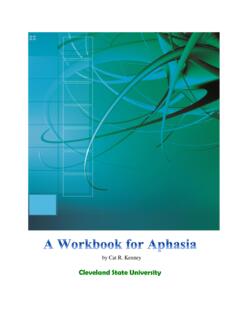Transcription of A Workbook for Aphasia - Weebly
1 Cleveland State University A Workbook for Aphasia by Cat R. Kenney 1 A Workbook for Aphasia LANGUAGE SECTION WORDS -Cross out the word that is not in the same -Fill in the words in the correct -Convergent naming ..10 -Divergent naming ..12 -Multiple meaning -Compound -Rhyming words: match the words that -Collective SENTENCE STRUCTURE -Phrase -Sentence _____ COGNITION SECTION COMPREHENSION -Figurative language (idioms)..37 GENERAL KNOWLEDGE -Yes/no -Countries, states, cities (locations)..40 -Popular media (songs, movies, television shows, sports, literature).
2 42 MEMORY -Rote naming -Recalling details about self and -Recalling visual details /describing from 2 FUNCTIONAL SKILLS SECTION FUNCTIONAL SKILLS -Television -Monthly calendar -Cooking a -Daily -Spatial -Temporal -Functional math: grocery -Functional math and writing: writing checks, balancing a checkbook, addressing -Functional writing _____ PUZZLES -Einstein s logic -Simple MELODIC INTONATION -Song A BEDSIDE ANSWER BANK for LITERATURE REVIEW, RESOURCES and 3 INTRODUCTION Aphasia is relatively common: according to the American Speech-Language and Hearing Association, approximately one million people in America have Aphasia (2008).
3 This Workbook is intended primarily for new or student clinicians and family members of those who have experienced Aphasia due to CVA or TBI and are in the process of recovery. Those assisting someone with Aphasia or a cognition problem may find its pages of use, and some activities might be helpful for those patients in the early stages of a progressive cognitive decline. Research shows that clients experience significant gains in cognitive-communication function after receiving speech-language therapy (Cicerone et al., 2000; ASHA Treatment Efficacy Summary). The data implies that 80% of patients with TBI who received speech therapy made improvements in cognition.
4 Newer evidence supports that speech and language treatment is effective in improving receptive and expressive language skills in individuals with Aphasia . (Brady, Kelly, Godwin, & Enderby, 2012. Retrieved from the ASHA website, 2014) There are several trains of thought in the world of therapy for CVA/TBI. There are those which focus on cognition, language, pragmatics, functional tasks, and life participation. There are those which encourage a high intensity schedule of therapy. There are those which eschew alternate means or supplemental communication for an all-verbal communication goal.
5 All have evidence which supports the effectiveness of each individual approach with certain patients. Most of the more popular workbooks focus on one type of therapy or another. The literature review included offers a glimpse of the many resource materials out there, and may guide you in selecting the type of Workbook that seems best for your individual case. Here are my own top choices to target the most often used types of therapy: Linguistic, cognitive, and functional tasks. --For hundreds of worksheets targeting language-specific tasks, look for the Aphasia Therapy Workbook by Julie Guerrero.
6 --For a large selection of cognition-based worksheets, seek the Therapy Guide for Language and Speech Disorders volume 2, by Kathryn Kilpatrick. The Cognitive Linguistic Task Book by Nancy Helm-Estabrooks is also excellent. -- For a diverse, and nicely illustrated, Workbook addressing functional tasks, you cannot do better than the Results for Adults books, by Christine Johnson and Melissa Baker. Hopefully, you will be inspired to create your own activities to help your client, patient, or loved one recover or hold on to-- as much language and cognitive ability as he or she is able.
7 One final note: I intended this Workbook to be free, to be used by anyone who might find a use for it. Please feel free to share it in a similar fashion, with credit, but do not try to sell or profit from its pages. Families of those facing the challenge of recovery have enough to worry about without spending more money on expensive workbooks. Student clinicians are also on tight budgets, and beginning clinicians often face a mountain of student loan debt. Hopefully it will be of use. --Cat R. Kenney, 2014 4 Acknowledgements Thanks to Patrick O Donnell, Denise Rogers, Kathy Kenney, Jim Pieknik, and my teachers and classmates in the CSU Speech and Hearing Program All worksheets and photographs within were created by, and are property of Cat Kenney.
8 Please use them freely with your clients, including photocopying them, but do not otherwise publish or print this material, post it on the web, or sell it for profit. Contact the author at 5 LANGUAGE SECTION WORDS -Cross out the word that is not in the same category -Fill in the words in the correct categories -Convergent naming -Divergent naming -Synonyms -Antonyms -Homonyms -Multiple meaning words -Compound words -Rhyming words: match the words that rhyme -Collective nouns SENTENCE STRUCTURE -Phrase completion -Sentence completion -Morphology GOAL IDEAS: Patient will categorize items during structured therapy tasks with 80% accuracy.
9 Patient will identify the grammatically correct word, given a choice of options, with 80% accuracy. 6 CATEGORY CROSS-OUT Level: easy Cross out the word that is not in the same category as the others: 1. ARM SHOE LEG HEAD 2. OAK FIR BIRCH RICE 3. SAW GLUE SCISSORS CLIPPERS 4. WINDEX SOAP SHAMPOO TOOTHPASTE 5. SOUP FLOUR SUGAR SALT 6. TUESDAY THURSDAY SATURDAY MOTHER S DAY 7. PURPLE CLEAR GREEN RED 8. CAT DOG PARAKEET WHALE 9.
10 GIN WHISKEY MILK VODKA 10. COAL SNOW TAR PITCH 11. SPOTTED FLANNEL CHECKERED STRIPED 12. SUN RAIN WIND DIRT 13. AIRPLANE ROLLER SKATES CAR SUBMARINE 14. FLEA TIGER ELEPHANT GIRAFFE 15. SIX DECADE FORTY TWELVE 16. FALL NOVEMBER WINTER SUMMER 17. AFRICA LONDON ROME SYDNEY 18. FRENCH FRIES VITAMINS HAMBURGER FRIED CHICKEN 19. PRESIDENT STUDENT QUEEN PRIME MINISTER 20.

